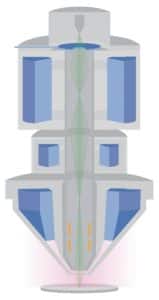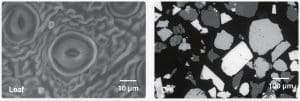The CIQTEK SEM3200 SEM Microscope is an excellent general-purpose Tungsten Filament Scanning Electron Microscope (SEM) with outstanding overall capabilities. Its unique Dual-anode electron gun structure ensures high resolution and improves image signal-to-noise ratio at low excitation voltages. Furthermore, it offers a wide range of optional accessories, making the SEM3200 a versatile analytical instrument with excellent expendabilities.
Intermittent Anode


The incident electron beam ionizes the air molecules on top of the surface, producing electrons and ions, in which ions neutralize the charged particles generated on the sample surface, achieving the effect of charge mitigation.
The secondary electron emission from the sample surface ionizes air molecules, generating electrons, ions, and photo signals simultaneously. The generated electrons then ionize other air molecules and a large number of photo signals are produced and then captured by a Low Vacuum Detector (LVD).
In high vacuum mode, LVD directly detects the cathodoluminescence signal emitted from the specimen, which can be captured for cathodoluminescence imaging, with simultaneous imaging from the BSED channel.
Using a vertically mounted chamber camera to capture optical images for specimen stage navigation allows for a more intuitive and accurate specimen positioning.
Under this mode, the astigmatism value of X and Y varies with the pixels. The image clarity is maximized at the optimal astigmatism value, enabling rapid stigmator adjustment.
Improved Automatic Brightness & Contrast, Automatic Focus, and Automatic Astigmatism Correction Functions. Imaging by a single click!
